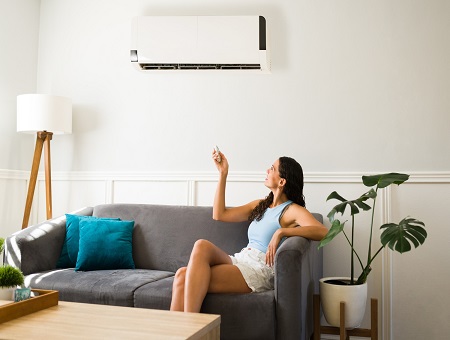How To Choose the Best Air Conditioning System for Your Home
 The best air conditioning system for your home depends on several practical factors, including its size, layout, how the space is used, and your budget. A well-selected system keeps your indoor environment comfortable and consistent, reduces long-term maintenance needs, and helps manage energy bills more efficiently. But with so many types and features available, it can be easy to overlook the practical details that matter most for daily use.
The best air conditioning system for your home depends on several practical factors, including its size, layout, how the space is used, and your budget. A well-selected system keeps your indoor environment comfortable and consistent, reduces long-term maintenance needs, and helps manage energy bills more efficiently. But with so many types and features available, it can be easy to overlook the practical details that matter most for daily use.
This guide breaks down key considerations to help you make a confident, informed decision based on how you live and the demands of your space.
1. Why Local Climate and Installation Quality Matter
The first step in choosing a system starts with understanding your climate and how it affects your cooling needs. Homes in areas with long, hot summers need systems that can run steadily for extended periods without performance drop-offs.
Cooling systems play a major role in maintaining indoor comfort throughout the year, particularly in areas with warm or unpredictable climates. Performance and efficiency depend on the unit and the quality of the installation. For instance, in Queensland’s subtropical regions, working with a team that specializes in Brisbane Air Conditioning helps reduce running costs and improves system reliability over time. It also means the installation is handled by local professionals who are familiar with regional building standards and environmental conditions.
In any location, poor installation can reduce airflow or limit the unit’s ability to regulate humidity levels. Taking climate into account early helps match the right type and size of the system to your actual needs.
2. Match System Type to Your Home’s Size and Layout
Not all systems are designed for the same environments. Smaller homes or apartments might benefit from traditional air conditioners like window units or wall-mounted models. These are cost-effective and relatively easy to install. But they often struggle to deliver efficient cooling for larger spaces or open-plan layouts.
For larger homes, ducted systems or heat pumps may be better suited. These options can deliver consistent temperatures across multiple rooms, with the added advantage of zoning features in some setups. This allows you to control temperatures in specific areas without overworking the system.
Make sure to consider the square feet each system can cover. Oversized units often turn on and off more frequently than necessary—a behavior known as short cycling—which can result in uneven cooling and increased wear on system components. Undersized systems, on the other hand, often run constantly without ever reaching optimal performance.
3. Pay Attention to Efficiency Ratings and Long-Term Costs
The initial purchase price isn’t the only number to factor in. Installation costs, maintenance frequency, and long-term energy use all affect the total expense of owning an air conditioning system.
Look at the seasonal energy efficiency ratio (SEER) to get a sense of how well a unit performs over an entire cooling season. A higher SEER rating typically reflects lower energy use, which translates to substantial energy savings. Units with inverter technology also help regulate power usage based on real-time demand rather than cycling on and off.
Smart thermostats can further improve control by adjusting temperature settings based on your schedule or habits. Features like sleep mode, voice commands, and remote control access can also help reduce unnecessary use, especially during off-peak hours.
4. Evaluate Features That Affect Day-to-Day Use
When comparing models, features that impact daily convenience often go unnoticed. Some units operate at significantly lower noise levels than others—which makes a big difference if the system will be placed near bedrooms, study areas, or living rooms.
The indoor unit’s size and design can also affect your space, especially in rooms with limited wall area or near a window frame. An LED display may be helpful for quick checks but might also be distracting at night. Think about how each feature fits into your routine. For example, voice commands might be a convenient bonus for some users but unnecessary for others.
Smart technology integrations are another consideration. If your home is already set up for smart controls, connecting your air conditioning to existing systems can streamline energy management. That said, make sure any smart features are user-friendly and backed by good customer support.
5. Air Quality and Indoor Comfort
Modern AC systems often provide more than temperature control. Many units now include air filtration or purification functions that help improve air quality—especially important if someone in your home has allergies or asthma. Some systems also help regulate humidity levels, which can reduce mold risk and increase indoor comfort during muggy weather.
Insulation quality in your walls and ceilings directly impacts how hard your system needs to work. Poor insulation allows heat to enter or escape easily, making it harder to maintain consistent temperatures. If your energy bills are consistently high, your insulation may be part of the problem, even if your AC system is running efficiently.
6. Reliability and Service Life
Even if two systems offer similar specs on paper, their lifespan and performance consistency may differ. Owner satisfaction often reflects real-world reliability, which includes how the system performs under extreme temperatures and how easily it can be serviced. Systems with widely available replacement parts and experienced local technicians tend to offer better long-term value.
Also consider how the system interacts with other elements in your home. If your home already uses a gas furnace for heating, integrating a compatible cooling system, such as a heat pump, can reduce installation costs and enhance energy efficiency throughout the year.
Final Thoughts
Choosing the best air conditioning system means balancing performance, cost, and convenience with how you live and what your space requires. Factor in the specs and how the unit will function day after day—in your rooms, with your habits, and during the months when you need it most.
Planning your system based on your home, habits, and climate helps avoid issues later and makes day-to-day use more comfortable.
